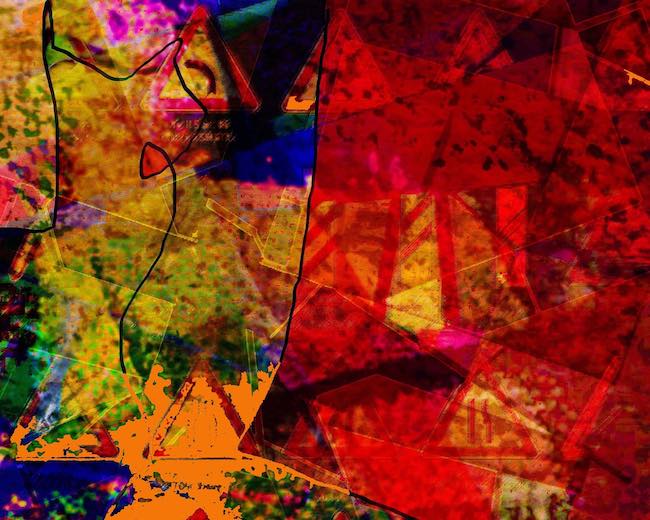Molto spesso nel cammino artistico si susseguono diverse fasi durante le quali il creativo sente l’esigenza di modificare il proprio stile adattandolo al sentire del momento, allo studio che sta approfondendo e anche alla curiosità che lo spinge a misurarsi con differenti modalità espressive e, nei tempi contemporanei, a mescolare le proposte avanguardiste e innovative del secolo scorso quando per assumere consistenza ogni linguaggio doveva rientrare all’interno di una ben definita corrente artistica. La protagonista di oggi, a sua volta poliedrica interprete dei tempi moderni, mette in sinergia diverse tecniche dando vita a un nuovo stile che si trasforma in vera e costante sperimentazione in cui l’emozione si accorda con l’analisi della modalità di narrarla.
Il Novecento fu un secolo eclettico e unico dal punto di vista della storia dell’arte poiché tutto ciò che era un punto fermo prima, venne sovvertito, rivoluzionato e cancellato in nome di un’esigenza di libertà e di affrancamento da tutte le regole stilistiche e accademiche che erano ormai un limite rispetto alle esigenze di un mondo che andava a una velocità completamente differente. Dalle prime battaglie compiute dai precursori che incontrarono le opposizioni del mondo culturale e critico, cominciate con i Fauves e l’Espressionismo per finire poi alle grandi correnti artistiche di rivoluzione totale come il Futurismo, il Cubismo e ancora l’Astrattismo, si percorse successivamente un cammino persino più audace che vedeva il rifiuto della figurazione e l’introduzione della materia fino a farla diventare assoluta protagonista di un’opera in cui l’analisi e l’approccio mentale dovevano prevalere su qualsiasi soggettività dell’esecutore. Intorno alla metà degli anni Cinquanta vi fu in alcuni artisti l’esigenza di un ritorno all’ordine e alle regole più tradizionali, generando movimenti che tendevano verso una fedeltà assoluta alla figurazione, mentre in altri continuò a prevalere la tendenza a esplorare, mescolare e dar vita a nuove tecniche tralasciando l’assolutismo degli anni precedenti, necessario tuttavia a rompere gli schemi e a far sentire una voce nuova, e spostandosi verso un approccio sperimentale in cui le nuove conoscenze potevano interagire ed entrare in dialogo dando vita a modalità espressive impensabili fino a poco prima. Ecco dunque che al fianco di correnti come il Fototorealismo e il Realismo Americano emersero creativi che andarono verso l’evoluzione dell’Informale Materico in cui l’oggetto, o parte di esso, entrava nella tela per sottolineare il concetto che l’esecutore voleva esprimere sia che fosse di tipo emozionale sia che fosse di tipo mentale, come nel caso del Dadaismo e del Nouveau Réalisme dove i materiali di scarto, i frammenti di vetro, i manifesti pubblicitari strappati, divennero uno spaccato ironico della società dell’epoca; e poi ancora altri si dedicarono completamente all’utilizzo di nuove tecnologie emergenti che generarono infinite possibilità realizzative e creative come la Computer Art poi evolutasi in Digital Art.
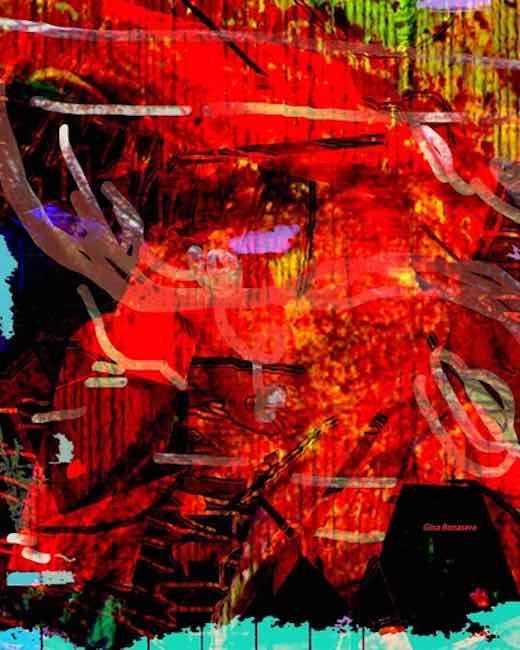
È in questo contesto sperimentale che si colloca il lavoro di Gina Bonasera, artista vivace e curiosa, pronta a lanciarsi in nuove sfide esecutive per dar voce a una sua personale impronta artistica anche in virtù della padronanza dei colori, delle tecniche apprese nel suo lungo percorso di studio cominciato con il maestro siciliano Vito Linares che la introdurrà alla filosofia del frammento, e alla calcografia con il professor Vito Galfano, tecniche poi ampliate all’interazione tra colore e materia, misurandosi con la pittura a olio, ad acrilico, le tecniche miste, le monotipie, il collage, gli smalti spray, la fotografia e il plotter painting.
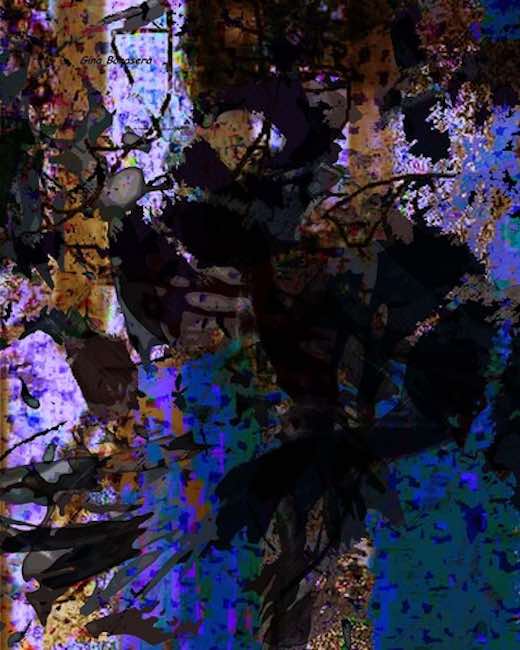
Solo negli ultimi anni ha scelto di dedicarsi ed evolvere la sua conoscenza della Digital Art nella quale sente di poter proseguire quel percorso dinamico e di propulsione verso la costante evoluzione che appartiene alla sua natura espressiva, tipica degli artisti che non riescono a fermarsi o a rientrare in una sola definizione bensì hanno bisogno di scrivere un proprio cammino diverso e personalizzato all’interno del quale potersi riconoscere, potersi esprimere e poter lasciare una propria traccia. Nella Digital Art Gina Bonasera trova la sua dimensione, quella che non solo le permette di ricostruire idealmente la tecnica dell’assemblage e del collage tipici del Nouveau Réalisme ma anche di sovrapporre gli strati dell’osservato dando vita a trasposizioni di quella che è la realtà attuale, con tutti i suoi limiti, i segreti celati, e le identità che ciascun essere umano si impedisce di rivelare all’esterno.
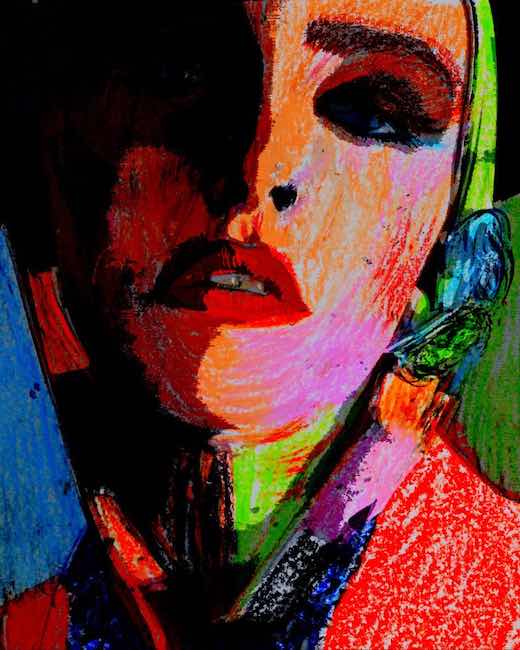
Dal punto di vista cromatico le opere sono vicine all’Espressionismo Astratto, per quella scelta di tonalità perfettamente accordate al ventaglio emozionale che Gina Bonasera ha bisogno di liberare e di sottolineare, senza però mai rinunciare a sussurrare altro, a lasciar intravedere quell’immagine reale più o meno nascosta che emerge a un secondo sguardo, quando l’occhio abbandona la sensazione ricevuta dall’insieme, dall’intensità dei colori che in qualche modo hanno la funzione di attrarre l’attenzione, e si sposta verso tutto ciò che sale verso la superficie.
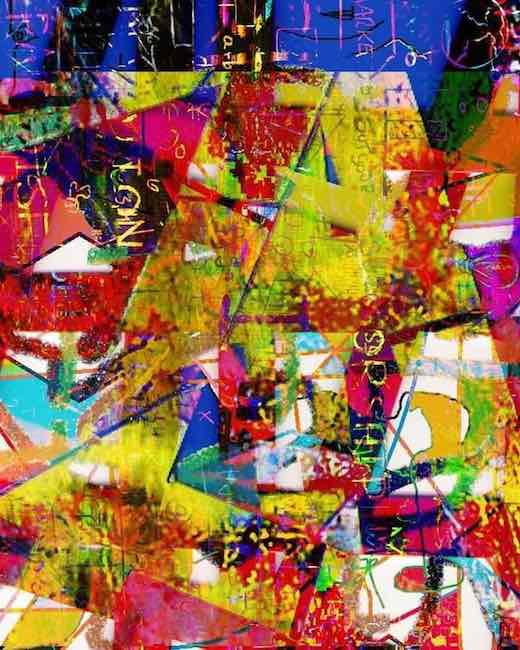
L’opera Appunti sembra rappresentare un taccuino di vita, di parole dette, di percorsi intrapresi e poi spesso abbandonati per correre dietro a nuovi obiettivi, di mosaici razionali che in alcuni casi hanno costituito una scelta obbligata pur costringendo l’individuo a mettere in secondo piano le sensazioni che poi sono tornate a emergere. In questo lavoro si svela l’anima Nouveau Réaliste dell’artista, per la tendenza a sovrapporre elementi come se appartenessero a ritagli di giornale, assemblati in maniera casuale eppure, grazie alle tonalità intense delle emozioni che hanno accompagnato le azioni, in grado di condurre la mente e l’interiorità verso un cammino compiuto che sembra fermare il tempo e mettere l’osservatore di fronte alle riflessioni su tutto ciò che è si è fatto e su cui troppo frequentemente ci si dimentica di soffermarsi.
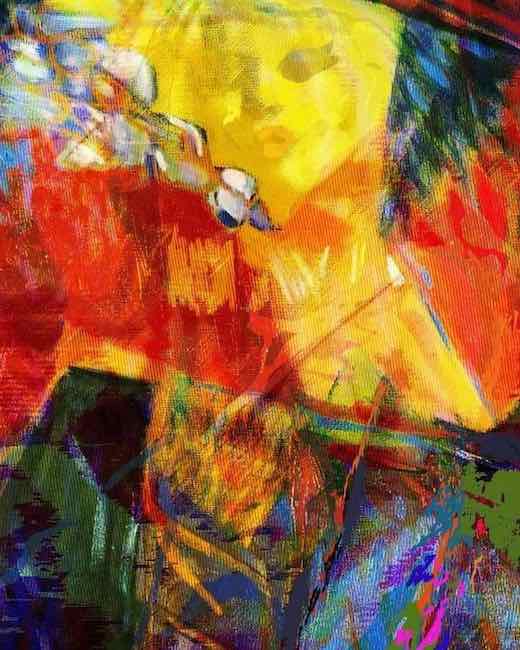
In Donne al bivio Gina Bonasera interviene in maniera più evidente dal punto di vista pittorico, la Digital Art sembra lasciare spazio a un mondo, quello femminile, che non può non essere descritto in maniera meno personale proprio perché infinitamente sfaccettato e necessitante di far sentire la propria voce, quella che soventemente rimane inascoltata fino a quando non sceglie di gridare; in questo lavoro invece emerge dal silenzio, si lascia osservare malgrado il velo, che sia di indifferenza o di disinteresse poco importa, che a volte nasconde l’essenza, cela le sensazioni più vere come se in qualche modo costituissero un motivo per sentirsi in difetto. Invece l’artista sceglie di dipingerle in acrilico, senza alcun tipo di omologazione, descrivendo un volto che può essere uno, nessuno e centomila, e che pur nella sua irriconoscibilità induce le donne a sentirsi parte di quell’espressione, trattenuta dalle stese catene che sembrano imprigionare la protagonista. Ma le tonalità scelte ne sottolineano la forza, la resilienza e il coraggio di rompere tutto ciò che la trattiene liberando un’essenza che non può più rimanere in silenzio.
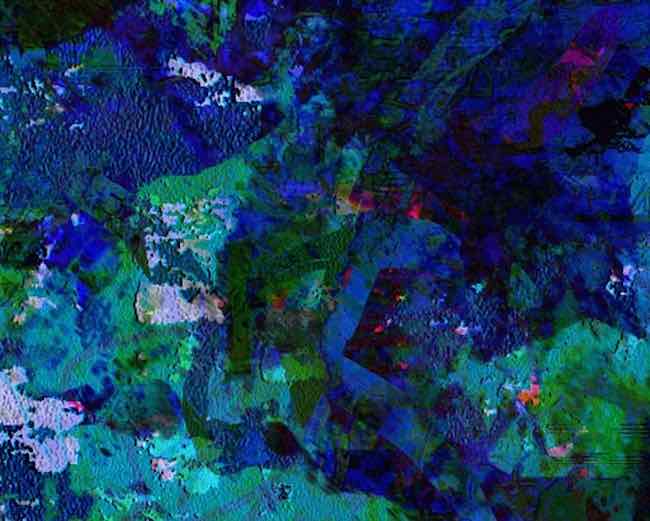
Nel lavoro Spring sea invece i colori diventano più scuri, sebbene legati al verde e al blu che caratterizzano i fondali di quel mare citato nel titolo, proprio perché Gina Bonasera probabilmente intende sottolineare quanta bellezza si nasconda anche nell’approfondimento della riflessione, anche nell’andare a guardare verso l’oscurità di ciò che non affiora in superficie e che conduce verso una sostanza differente, più concreta, più intensa. D’altro canto però l’evocazione della primavera, intesa come momento di rinascita, sembra esortare il fruitore a meditare su quanto dopo un percorso introspettivo si possa raggiungere una nuova consapevolezza, quanto dopo il momento di raccoglimento in se stesso e dell’esame su ciò che ha costituito o provocato un evento, si possa trovare una nuova luce e sulla base di quest’ultima ricominciare un cammino differente e forse più affine.
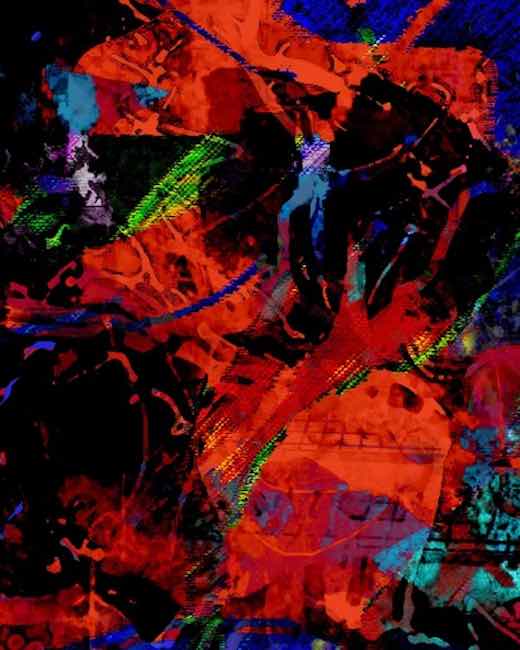
Gina Bonasera fa parte della corrente artistica Espansionismo ideata dal Maestro Albino Pitti, del gruppo 99 Quanti, Gruppo di Ricerca Arte Quantistica, ideato dalla pittrice e giornalista Lorena Ulpiani e supportato del pensiero del sociologo Paolo Prandstraller. È tra gli artisti di AIAPI UNESCO, in possesso della Carta d’identità internazionale di artista professionista. Ha al suo attivo molte mostre in Italia e all’estero, le sue opere si trovano in collezioni private e pubbliche, pinacoteche, musei, fondazioni, istituti scolastici. All’attività pittorica associa anche un ruolo letterario come poetessa riconosciuta e tradotta in molte lingue.
GINA BONASERA-CONTATTI
Email: luigiabonasera@libero.it
Sito web: http://www.ginabonasera.com/
Facebook: https://www.facebook.com/gina.bonasera
Instagram: https://www.instagram.com/bonaseragina/
The interactive pictorial experiences of Gina Bonasera, between Digital Art and fragments of Nouveau Réalisme
Very often in the artistic journey there are different phases during which the creative feels the need to modify his style, adapting it to the feeling of the moment, to the study that he is deepening and also to the curiosity that pushes him to measure himself with different modes of expression and, in contemporary times, to mix the avant-garde and innovative proposals of the last century when, in order to take on consistency, each language had to fall within a well-defined artistic current. Today’s protagonist, herself a multifaceted interpreter of modern times, combines different techniques to create a new style that turns into true and constant experimentation in which emotion is in tune with the analysis of the way of narrating it.
The 20th century was an eclectic and unique century from the point of view of art history as everything that had been a fixed point before was subverted, revolutionised and cancelled in the name of a need for freedom and liberation from all stylistic and academic rules that were now a limitation compared to the needs of a world moving at a completely different speed. From the first battles waged by the forerunners that met with opposition from the cultural and critical world, which began with the Fauves and Expressionism and ended with the great artistic currents of total revolution such as Futurism, Cubism and Abstractionism, an even bolder path was followed that saw the rejection of figuration and the introduction of matter until it became the absolute protagonist of an artwork in which analysis and mental approach had to prevail over any subjectivity of the executor. Around the mid-1950s, there was a need in some artists for a return to order and more traditional rules, generating movements that tended towards an absolute fidelity to figuration, while in others, the tendency to explore, mix and give life to new techniques continued to prevail, leaving aside the absolutism of previous years, which was nonetheless necessary to break the mould and make a new voice heard, and moving towards an experimental approach in which new knowledge could interact and enter into dialogue, giving rise to expressive modes that had been unthinkable until recently.
Thus, alongside currents such as Photorealism and American Realism, emerged creatives who moved towards the evolution of Material Informalism, in which the object, or part of it, entered the canvas to emphasise the concept that the artist wanted to express, whether it was emotional or mental, as in the case of Dadaism and Nouveau Réalisme, where discarded materials, fragments of glass, torn advertising posters, became an ironic cross-section of the society of the time; and then others devoted themselves completely to the use of new emerging technologies that generated endless realising and creative possibilities such as Computer Art that later evolved into Digital Art. It is in this experimental context that the work of Gina Bonasera is set. She is a lively and curious artist, ready to launch herself into new executive challenges in order to give voice to her own personal artistic imprint, also by virtue of her mastery of colours, of the techniques learnt in her long course of study that began with the Sicilian master Vito Linares who introduced her to the philosophy of the fragment and chalcography with Professor Vito Galfano, techniques that were then extended to the interaction between colour and matter, measuring herself with oil painting, acrylic painting, mixed techniques, monotypes, collage, spray enamels, photography and plotter painting. It is only in recent years that she has chosen to devote herself and develop her knowledge of Digital Art, in which she feels she can pursue that dynamic and propulsive path towards constant evolution that belongs to her expressive nature, typical of artists who are unable to stop or fit into a single definition, but need to write their own different and personalised path within which they can recognise themselves, express themselves and leave their own mark. In Digital Art, Gina Bonasera finds her dimension, the one that not only allows her to ideally reconstruct the assemblage and collage technique typical of Nouveau Réalisme, but also to superimpose the layers of the observed, giving life to transpositions of what is current reality, with all its limits, hidden secrets, and identities that each human being prevents himself from revealing to the outside world.
From a chromatic point of view, the artworks are close to Abstract Expressionism, for that choice of tones perfectly in tune with the emotional range that Gina Bonasera needs to liberate and emphasise, but without ever renouncing to whisper something else, to allow a glimpse of that real, more or less hidden image that emerges at a second glance, when the eye abandons the sensation received from the whole, from the intensity of the colours that somehow have the function of attracting attention, and moves towards everything that rises to the surface. The work Notes seems to represent a notebook of life, of words spoken, of paths taken and then often abandoned in order to run after new goals, of rational mosaics that in some cases constituted a compulsory choice while forcing the individual to put the sensations that then emerged into the background. In this artwork, the artist’s Nouveau Réaliste soul is revealed, due to the tendency to superimpose elements as if they belonged to newspaper cuttings, assembled in a random manner and yet, thanks to the intense tones of the emotions that accompanied the actions, able to lead the mind and interiority towards a completed path that seems to stop time and confront the observer with reflections on all that has been done and on which we all too often forget to dwell. In Women at the Crossroads, Gina Bonasera intervenes in a more evident manner from a pictorial point of view, Digital Art seems to leave room for a world, the female world, which cannot but be described in a less personal manner precisely because it is infinitely multifaceted and in need of having its voice heard, the one that often remains unheard until it chooses to cry out; in this work, on the other hand, it emerges from silence, it allows itself to be observed despite the veil, whether of indifference or disinterest is of little importance, which sometimes conceals the essence, hides the truest sensations as if they somehow constituted a reason to feel at fault.
Instead, the artist chooses to paint them in acrylic, without any kind of homologation, describing a face that can be one, none and a hundred thousand, and that despite its unrecognisability induces women to feel part of that expression, held by the same chains that seem to imprison the protagonist. But the shades chosen emphasise her strength, resilience and the courage to break all that holds her back, freeing an essence that can no longer remain silent. In the artwork Spring sea, on the other hand, the colours become darker, although linked to the green and blue that characterise the seabed of that sea mentioned in the title, precisely because Gina Bonasera probably intends to emphasise how much beauty is also hidden in the deepening of reflection, even in going to look towards the obscurity of what does not appear on the surface and which leads towards a different, more concrete, more intense substance. On the other hand, however, the evocation of spring, understood as a moment of rebirth, seems to urge the viewer to meditate on how much, after an introspective path, a new awareness can be reached, how much, after the moment of recollection within oneself and the examination of what constituted or provoked an event, a new light can be found and on the basis of this new light a different and perhaps more similar path can begin again. Gina Bonasera is a member of the Espansionismo artistic current conceived by Maestro Albino Pitti, of the 99 Quanti group, Gruppo di Ricerca Arte Quantistica, conceived by painter and journalist Lorena Ulpiani and supported by the thought of sociologist Paolo Prandstraller. She is one of the artists of AIAPI UNESCO and holds the International Professional Artist’s Identity Card. She has many exhibitions in Italy and abroad to her credit, and her artworks can be found in private and public collections, picture galleries, museums, foundations and educational institutions. In addition to her painting activity, she also associates a literary role as a recognised poetess who has been translated into many languages.


